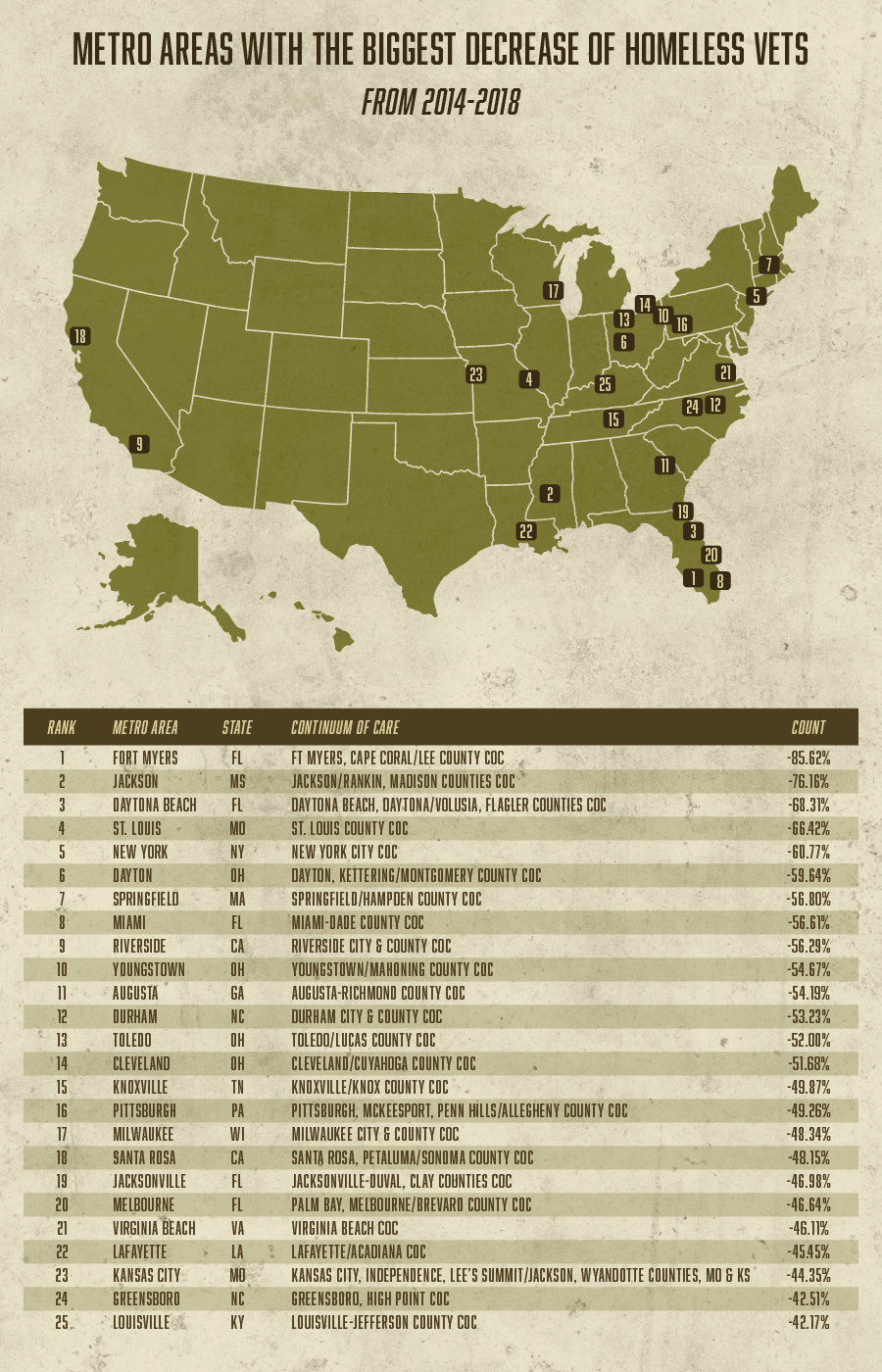US Cities with the Highest Number of Homeless Veterans
One of the most tragic aspects of war is the toll it takes on the people who risk their lives to protect our country. In an appalling number of cases, soldiers return home suffering from Post-Traumatic Stress Disorder, addiction, and a host of other repercussions that they carry with them as a result of combat. In far too many of these cases, these heroes do not receive the help they need to combat the emotional repercussions of their service. One far too common end result? They end up homeless on the streets they devoted their lives to protecting.
This study examines the highest occurrence of veteran homelessness throughout the 50 largest cities in the United States. Based on estimates by the HUD Exchange, we have identified which cities have the highest number of homeless veterans. Our findings are below.

The count of homeless veterans is determined by the number included in a Continuum of Care (CoC) Geographical Area. Based on the areas included, we were able to equate the CoC’s to metropolitan statistical areas and in turn, to cities. Based on this data, we found that Los Angeles, a city known for opulent homes and wealthy movie stars, is home to the highest count of homeless veterans by a huge margin. Nearly 8,000 veterans live on Los Angeles streets. San Diego, the city with the second-highest number of veterans, has less than half that number. Seattle comes in third with just over 2000 homeless veterans. New York comes in fourth, which makes it the most problematic East Coast city from a standpoint of homeless veterans.

Of course, depending on the city size, there does tend to be a higher homeless population in general, and homeless veterans are included in those numbers. Accordingly, we examined cities with the highest number of homeless veterans per 100,000 people. Honolulu, Hawaii was the only city to break 100 for the ratio of homeless veterans to the general population. San Diego and Santa Rosa came in second and third with the only other numbers in the 90s. Melbourne, San Jose, and Las Vegas are the last cities to have a ratio of above 70 homeless veterans per 100,000 citizens.

Looking at the year-over-year changes in the number of homeless veterans in each city, the city with the highest percentage increase was Albany, NY by far. Their homeless veteran population grew by nearly 80% over 5 years, almost 15% more than Sacramento, which came in second place. Worcester, Baltimore, and Rochester round out the top 5 cities with the highest growth in homeless vets over 5 years and are the last cities to have a growth rate of over 40%.

On the other end of the scale, there are cities with remarkably few homeless veterans. Provo-Orem, UT has just 12 homeless veterans according to our source. Youngstown, OH follows with just 34, followed by Fort Myers and St. Louis, both of which have counts of under 50.

As for the lowest ratio of homeless veterans per 100,000 people, St. Louis and Provo-Orem have the lowest numbers by far. Both of them have fewer than 2 homeless veterans per 100,000 people. Baltimore comes in third and is the last city to have a count of under 5 homeless vets per 100,000 citizens.

Although homelessness among American veterans is a huge problem, there are areas where the number of homeless veterans has decreased over the past 5 years. Fort Myers is the best example of this, with an overall decrease of 85%. Jackson is close behind with a decrease of 76%, followed by Daytona Beach, St. Louis, and New York, all of which have decreased homeless veterans rates by over 60%.
The fact that any American soldier is left homeless after their service is a tragedy beyond words. There are a variety of reasons that veterans are at high risk for homelessness, but the fact that post-traumatic stress is often accompanied by substance abuse issues is certainly a factor. If you know a veteran who is struggling with addiction, you can find resources to help their unique case here.
Can I use this information?
The information and graphics in this blog post can be used and displayed by all commercial and non-commercial websites without charge. However, use is only permitted with proper attribution to deserthopetreatment.com. When using this information or any of these graphics, please include a backlink to this page.